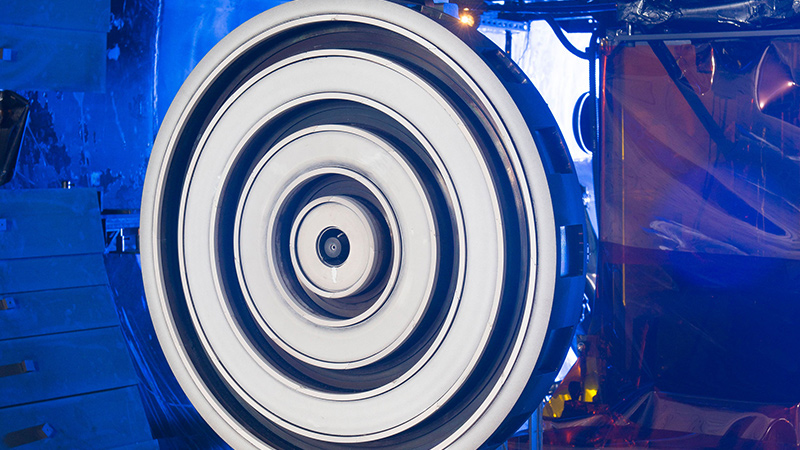Stay Up to Date
Submit your email address to receive the latest industry and Aerospace America news.
The Electric Propulsion Technical Committee works to advance research, development and application of electric propulsion for satellites and spacecraft.
For the electric propulsion community, 2017 marked a year in which electric rockets steadily became more mainstream.
In June, NASA’s Dawn spacecraft completed a one-year extended mission around the dwarf planet Ceres. The mission was enabled by Dawn’s ion propulsion system. The system has operated for a record-breaking 50,600-plus hours and provided 11.3 kilometers per second delta-v.
Eight colloid micro-Newton thrusters — developed by Massachusetts-based Busek Co. with support from NASA’s Jet Propulsion Laboratory in California — flew on the European Space Agency’s Laser Interferometer Space Antenna Pathfinder spacecraft and met all mission requirements. These thrusters are the first to demonstrate control of a spacecraft to within 10 nanometer per square root of hertz of positioning noise.
The Israeli-French Vegetation and Environment monitoring on a New Micro-Satellite, or VENμS, which uses two IHET-300 Hall thrusters from Rafael, was launched Aug 2. Each thruster operates at powers between 300 and 600 watts. This system will perform orbit transfer, orbit maintenance and fine pointing of instruments.
Early in 2017, the Chinese tested two high-throughput Hall thrusters aboard the Shijian-17 satellite. The two thrusters were the Harbin Institute of Technology’s 1.5-kilowatt HEP-100MF and the Lanzhou Institute of Physics’ 1.35-kW LHT-100.
On May 5, India’s Space Research Organization launched its first satellite equipped with electric propulsion. The GSat-9 uses the Russian KM-45 Hall thruster by Keldysh Research Center for station keeping.
Boeing launched its fifth all-electric satellite May 18 and Airbus Defense and Space launched its first June 1. With 20 all-electric communication satellites now on order, the share of all-electric is approaching a quarter of the communication satellite market. The power level of electric propulsion devices that have been used on-orbit now range from about 10 W to 4.5 kW.
Back on Earth, NASA and Aerojet Rocketdyne’s Advanced Electric Propulsion System, or AEPS, a 14-kW Hall thruster system, completed preliminary design review in August. Throughout the year, NASA’s Glenn Research Center in Ohio and JPL performed wear testing, accelerated deposition testing, discharge channel material testing, environmental testing and component life modeling. NASA developed a reference human exploration architecture that includes a 50-kW Power and Propulsion Element, which will use the AEPS propulsion string.
Aerojet Rocketdyne, with Ohio-based subcontractor ZIN Technologies, in April completed fabrication of prototype NEXT-C gridded ion thruster and power processing unit. Development testing occurred throughout the year with critical design review scheduled for 2018. One thruster and PPU are reserved for the Double Asteroid Redirection Test mission scheduled for launch in 2020.
In January, NASA’s Discovery program selected the Psyche mission to explore a 200-kilometer metal asteroid thought to be a destroyed proto-planet core. The mission is scheduled to launch in 2022 and will use an SPT-140 Hall thruster system on a spacecraft jointly built by JPL and Space Systems Loral.
Busek’s iodine-fueled BIT-3 RF ion thruster system completed critical design review in June. BIT-3 will provide propulsion for Lunar IceCube, a secondary payload on the Space Launch System Exploration Mission-1. Additionally, a Busek iodine-fueled BHT-600 Hall thruster system began long-duration testing in July at Glenn.
In August at Glenn, a team including the University of Michigan, Aerojet Rocketdyne and JPL tested the NextSTEP X3 Nested Hall Thruster to a power level of 100 kW. This represented the first time a Hall thruster had been operated at discharge current above 100 amperes.
In June, Boeing selected the PPS 5000 5-kW Hall thruster for commercial satellite applications. Qualification testing of the PPS 5000 5-kW Hall thruster had been proceeding smoothly at Safran. Also in 2017, the first flight sets of PPS 1350 1.5-kW Hall thrusters were delivered to SSL.
With these projects and more, a revolution in how spacecraft makers and mission planners utilize electric propulsion is steadily gaining momentum.
Related Posts
Stay Up to Date
Submit your email address to receive the latest industry and Aerospace America news.




